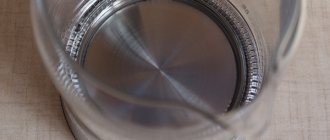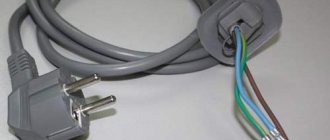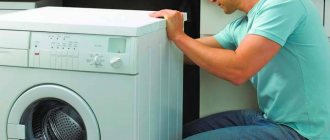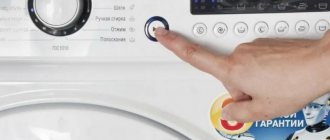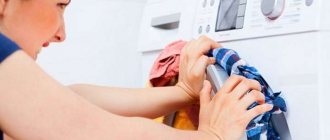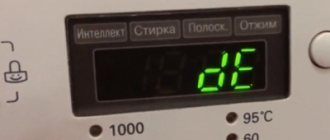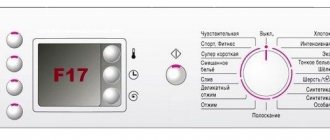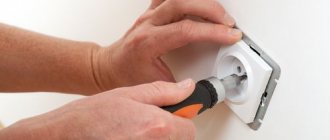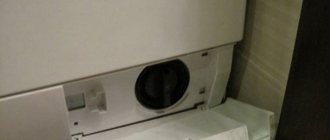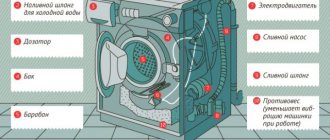When buying a washing machine, study its technical characteristics. Users are most interested in how many programs it contains, what it looks like and how many things can be loaded into the drum, without taking into account other indicators.
These large household appliances are classified according to the following parameters: washing efficiency, spinning, energy consumption. The power inherent in a washing machine is one of the key ones that determines how economical and productive the equipment will be.
Classification of washing machines by energy consumption
To find out how much electricity a device consumes, look at what energy efficiency class it belongs to. For this purpose, there is a letter designation on the label or warranty card: from “A” to “G”. "A" is the most economical option. “G” – costly.
Sometimes there is a “+” sign next to the letter, indicating reduced electrical energy consumption. The most economical household appliances will be those marked “A+++”.
Washing machine power consumption
How much light in watts this technique will “pull” depends on the energy consumption class to which it belongs:
- "A++". Equipment of this class requires less than 0.15 kW/h per 1 kg of laundry;
- "A+". Energy consumption – less than 0.17 kW/h per 1 kg;
- "A". To wash a kilogram of clothes, you need from 0.17 to 0.19 kW/h;
- "B". Consumes 0.19 – 0.23 kW/h per 1 kg;
- "WITH". Approximate light consumption per 1 kg of loaded laundry is from 0.23 to 0.27 kW/h;
- "D". Energy consumption parameter – 0.27 – 0.31 kW/h.
There are also other classes, however, there is no point in considering them, since they are used less and less in the equipment currently produced. The classes coming after “D” consume from 0.31 kW/h per 1 kg of laundry.
Parameters of modern Bosch machines
Energy consumption classes below level “D” are no longer produced, as they are too expensive to operate and have completely lost popularity. Nowadays you rarely even see machines with “C” and “B”, especially among Bosch - even the most budget Bosch washing machines have an “A” or “A+” sticker. Let’s look at how profitable such models are in a mini-review.
Almost all modern Bosch have an energy consumption class from “A” to “A+++”.
Modern machines from Bosch offer both reduced energy consumption and advanced functionality. We must not forget about the build quality - the “Germans” have proven themselves excellent, delighting with high quality and long service life. The main thing is to take the choice of model seriously, comparing all technical indicators.
Washing machine power consumption
Washing machine control unit
Washing machines are complex multifunctional household appliances that can heat water, wash clothes, spin them and drain the water. There are often models with a “drying” function. Which nodes “pull” the light:
- electric motor;
- heating element;
- pump that drains water;
- Control block.
The motor responsible for rotating the drum and the electric heater (TEH) consume the most electricity, but they operate periodically rather than constantly.
To make a calculation of energy consumption per hour, it is not enough to multiply the “total” watts with time. The power consumption of washing equipment depends on many factors: the number of revolutions of the electric motor, programs, water heating temperature, and drum load.
Electric motor
Washing machine motor
The engine is the main link of this technology. Its function is to rotate the drum. An electric motor is a part that consumes most of the light. The main types of motors found in such devices:
- asynchronous;
- collector;
- brushless.
Two-phase asynchronous motors are no longer installed in new models. Most manufactured devices use inverter commutator or brushless electric motors.
Collector “engines” do not last long, as their brushes wear out.
At the moment, well-known brands such as LG, Samsung, Siemens, Bosch, Indesit and others produce washing machines with brushless electric motors.
This technique “pulls” 20% less light, makes less noise during operation and can operate for about 10 years without replacing parts. The power of these engines is 400 - 800 W.
heating element
Washing machine heating element
The heating element is an element that heats the water in the tank to the temperatures required by the selected program. If the equipment has a powerful heating element, then it will “pull” more light per unit of time.
The average power consumption will not change much, because a powerful heating element will heat up the water faster than a low-power element.
The surface of the heating element may become covered with limescale, which causes the water to take longer to heat up.
At the same time, light consumption will also increase. The problem can be solved simply: pour citric acid into the equipment’s loading tray and run the standard program.
The power inherent in modern heaters is 1.7 - 3 kW.
Drain pump
This part pumps water out of the tank. The pump can operate several times during a wash, depending on the selected mode.
The design itself looks like an impeller rotated by a compact electric motor.
At the inlet, its blades draw in water, and at the outlet, they push it out, from where it flows to the drain hose. Such pumps practically do not draw light, since their power consumption is from 25 to 40 W.
Electronic control unit
Display panel
An important node, including:
- CPU;
- display panel;
- starting capacitors;
- power supply used to obtain low-voltage voltages and other parts.
There are many components in the electronic unit, but the device itself requires virtually no electricity. It only needs 10 - 15 watts.
Bosch wll2416eoe
The rigid, vibration-resistant frame design of the device provides stability and quieter sound during operation. The inverter motor reduces noise due to the absence of friction of parts. Externally it looks stylish, with its shape and white body color it will easily fit into any interior. A wide selection of working programs makes it possible to select a mode for washing a certain type of item, be it sportswear or children's clothing, jeans, etc.
| Loading | 6 kg |
| Energy consumption | A |
| Spin efficiency | IN |
| Rotation speed (spin) | 1200 rpm |
| Energy consumption | 0.13 kWh/kg |
Cost from 27,500 to 32,370 rubles.
pros
- laundry reloading function;
- ease of use;
- presence of delayed start;
- suitable for people with sensitive skin;
- possibility to select optimization of washing programs thanks to VarioPPerfect;
- ActiveWater function allows you to choose full or half load;
- quiet;
- the ability to adjust the volume of sound signals, which is good for working at night;
- does not jump;
- after the end of the wash it turns off;
- the display shows all the necessary information;
- child lock;
- good spin;
- accelerated washing mode.
Minuses
- the ultra-sensitive sensor is easy to accidentally touch;
- Locking the keys when washing will not help with children, because... when turning the main handle to the “Off” state the machine turns off, but when turned on it continues to erase from the place where it stopped the cycle;
- the control panel, where there is a touch screen, has a play when pressed with a finger;
- can automatically increase the washing time;
- lack of drying.
Wonderful thing. Before this I had a machine from LG, compared to it the difference is obvious. Doesn't rattle, doesn't knock, washes outerwear, blankets, down jackets well. I started it overnight and by morning everything was ready. Beauty!
READ MORE: The principle of operation of the washing machine and its structure, operating diagram, algorithm and mechanism Indesit, LG, Samsung, Ariston, Electrolux, Bosch
Bosch WLL2416EOE
How to determine the power of a washing machine
Power consumption is calculated in laboratory conditions. Experts estimate how much equipment spends kWh per 1 kg of loaded items. To test any models, equal conditions are taken: a full washing cycle is turned on with a maximum load (usually 5 kg) and a water temperature of +60 degrees.
Cotton items are used as linen. After completing the cycle, the model is assigned a certain energy consumption class.
The simplest method for determining power, without visiting laboratories, is to study the technical characteristics of the model. The power parameter is indicated in the passport or on a label pasted on the case.
Equipment with a “drying” function has its own energy consumption scale. Electrical energy consumption is calculated in the same way as for classical machines.
How many kilowatts does a washing machine consume?
Based on the data described above, the average consumption is as follows:
- 400 - 800 W during washing;
- approximately 2 kW for heating water (the heating element is turned on). There are models that consume about 2900 W.
Light consumption largely depends on the energy consumption class. Drum loading, mode, temperature - all this is reflected in the final figure. According to average data, equipment spends from 0.3 to 1.6 kW/h per cycle.
If you buy large equipment with a “drying” function and a capacious drum for 6–7 kg of laundry, then energy consumption can exceed 1.6 kW/h.
Standard models with a “capacity” of 5 kg per wash require no more than 0.8 kW per hour. In Moscow, the price of 1 kW is 5.38 rubles. It turns out that the price of one wash is 4.3 rubles.
Now for detailed calculations. If the washing machine is turned on three times a week, with three wash cycles per day, then in 12 days this is 36 washes:
- per month. 0.8 x 36 = 28.8 kW/h. Multiply by the tariff (5.38), you get 155 rubles;
- in year. 36 x 12 x 0.8 = 345.6 kW/h = 1838 rubles.
How to save electricity
Scale on the heating element
There are simple rules of economy, adhering to which, equipment will not consume more light than it needs:
- select the appropriate mode. If the laundry only needs to be rinsed, there is no point in setting the temperature to +50 degrees Celsius. Most of the electricity is used to heat the water and spin the clothes at the end of the cycle;
- When choosing a machine, look at its inherent energy efficiency category. The most economical models are marked “A” and “B”;
- If the house has a two-tariff meter, then it is better to run the machine at night. At night the price per 1 kW decreases. It is more convenient if the model has a “delayed start” function;
- The equipment should only be started when enough dirty laundry has collected to load a full drum. You shouldn’t wash one T-shirt at a time, hoping that the washing machine will draw less light. Consumption per cycle does not depend on drum load;
- From time to time you need to clean the heating element from scale. If this is not done, the water will take longer to heat up;
- When washing particularly dirty laundry, instead of putting it in the drum several times, it is better to pre-soak the item in a bowl of warm water and detergent.
The best thing is to carefully monitor things and use them carefully so as not to “put” greasy stains.
The power of large household appliances is indicated in the passport or on a label stuck on the body. Washing machines are divided by energy efficiency class, so it is better to immediately take a closer look at a more “economical” model. It will not be superfluous to follow simple operating rules, which will save treasured kilowatts.
Factors
Many different factors influence the number of kilowatts consumed by a washing machine.
- Service life of household appliances. That is, the more the washing machine works, the more formations accumulate on the heating element. Such formations significantly complicate the operation of the machine and the process of heating water, accordingly increasing power consumption;
- The type of clothing and fabric also greatly affects the power consumption of the washing machine. The thing is that wet fabric differs from dry fabric in weight and, accordingly, requires different electricity consumption;
- The load on household appliances greatly affects energy consumption. The calculation of the amount of electricity consumed is taken per kilogram of laundry, therefore, the more you load the drum, the more power consumption the washing machine needs;
- The washing program also affects the electricity consumption. It also talks about the temperature required for washing. High temperatures will require large amounts of electricity. A long washing process increases the amount of kilowatts consumed.
Similar articles:
- What do the icons on a washing machine mean: what symbols are on different brands of machines, photos
- Washing modes in a Zanussi washing machine
- A Quick Guide to Margherita 2000, Argherita | Ariston AL 109 X Operating Instructions | Page 2 / 14
- How to turn off the beep? — Bosch SPV 40M20RU [Answers 1]
